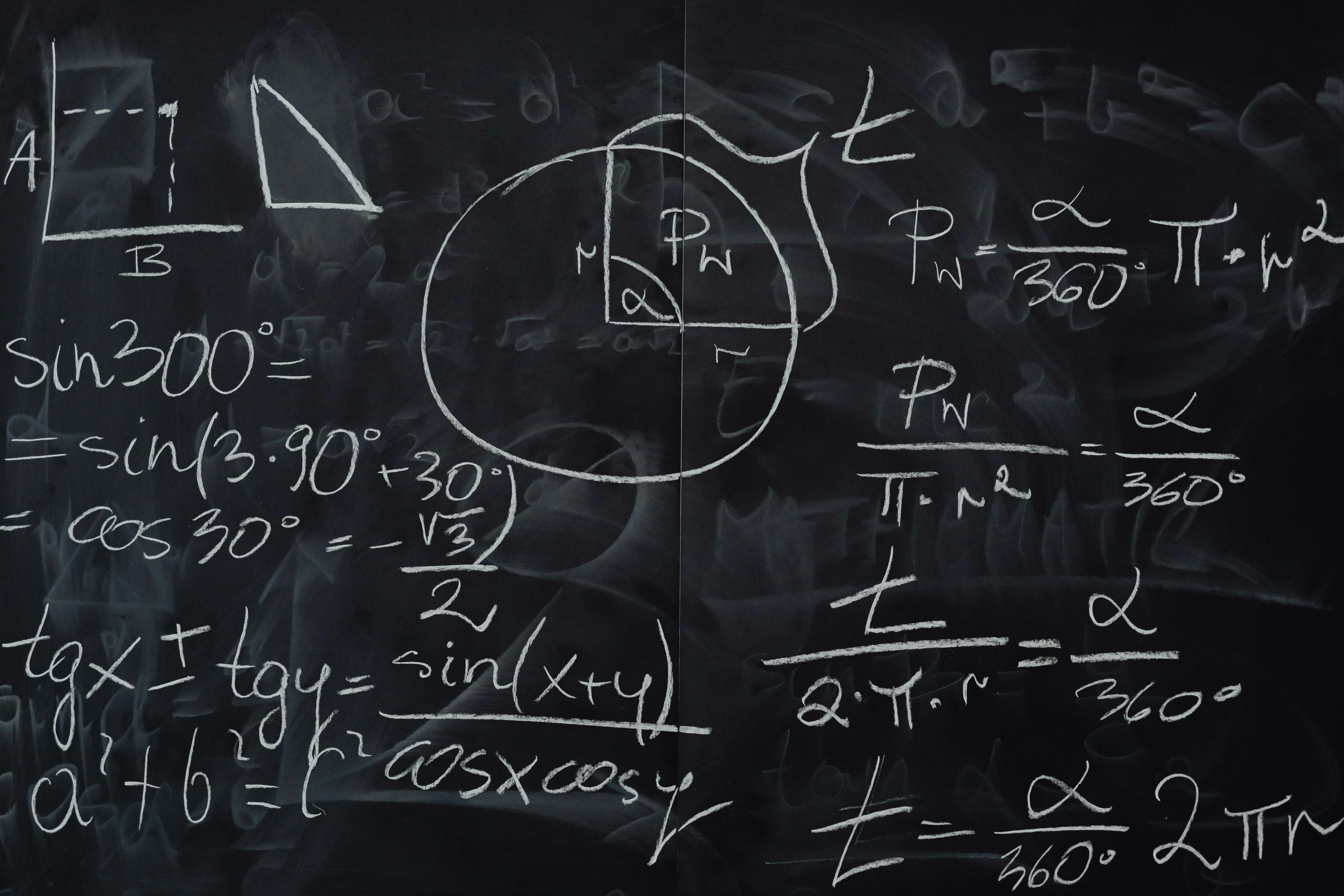Some Linear Algebra Proofs
1. Let \(n\) be a positive integer. Show that every matrix \(A \in M_{n \times n}(\mathbb{R})\) can be written as the sum of two non-singular matrices.
Proof: To prove this, we will use two known properties of matrices.
- \(det(A)=\) Product of the eigenvalues of \(A\)
- If \(\lambda\) is an eigenvalue of \(A\) then \(\lambda+n\) is an eigenvalue of \(A+nI\) matrix.
Since, \(A\in M_{n\times n}(\mathbb{R}),\) let \(\lambda_i\) for \(1\le i\le n\) be the eigenvalues of \(A\). The matrix \(A+(n+1)I\) has eigenvalues \(\lambda_{i+n+1}\) for \(1\le i\le n\).
Let,
\[\begin{align*}
n&=max\{|\lambda_i| : 1\le i \le n\}\\
\implies& -n\le \lambda_i \le n \text{ for all }1\le i \le n\\
\implies& -n+n+1\le \lambda_i+n+1 \le n+n+1\text{ for all }1\le i \le n\\
\implies& 1\le \lambda_i+n+1 \le 2n+1\text{ for all }1\le i \le n
\end{align*}\] Thus, \(\lambda_i+n+1\ge 1\) that is \(\lambda_i+n+1 \ne 0\) and \(0\) is not an eigenvalue of \(A\).
Now, from property (1), we have,
\(det(A)=\prod_{i=1}^{n}\lambda_i\)
and
\[\begin{align*}
det(A+(n+1)I)&=\prod_{i=1}^{n}(\lambda_i+n+1)\ne 0\\
\end{align*}\] \(\implies A\text{ or }A+(n+1)I\) both are non-singular.
\(-(n+1)I\) is of course non-singular.
Then
\(A=(A+(n+1)I)+(-(n+1)I)\)
2. Let \(\alpha \in \mathcal{L}(V)\) and \(\dim V=n< \infty\)
Suppose that \(\alpha\) has two distinct eigenvalues \(\lambda\) and \(\mu\). Prove that if \(\dim E_{\lambda}=n-1\) then \(\alpha\) is diagonalizable.
Proof: Since \(\mu\) and \(\lambda\) are two distinct eigenvalues associated with \(\alpha\), so \(V=E_{\lambda}\bigoplus E_{\mu}\) and \(\dim E_{\lambda}(\alpha)+\dim E_{\mu}(\alpha)=n\).
Here, \(\dim E_{\mu}(\alpha)\ge 1\) and \(\dim E_{\lambda}(\alpha)=n-1\). So,
\(\dim E_{\lambda}(\alpha)+\dim E_{\mu}(\alpha)=n-1+1=n\)
3. Let \(\alpha\in \mathcal{L}(V)\) and \(0\ne v\in V\) where \(\dim V=n< \infty\).
- Prove that there is a unique monic polynomial \(p(t)\) of the smallest degree such that \(p(\alpha)(v)=0\)
Proof: Since \(V\) is finite-dimensional so there exists smallest \(k\) such that \(\{v,\alpha(v),\cdots,\alpha^{k-1}(v)\}\) is linearly independent but \(\{v,\alpha(v),\cdots,\alpha^{k-1}(v),\alpha^k(v)\}\) is linearly dependent. So there exists \(c_0,c_1,\cdots,c_k\in \mathbb{F}\) not all zero such that
\(c_0v+c_1\alpha(v)+c_2\alpha^2(v)+\cdots+c_{k-1}\alpha^{k-1}(v)+c_k\alpha^k(v)=0\)
Without loss of generality, let’s assume that \(c_k\ne 0\). Then
\(a_0v+a_1\alpha(v)+a_2\alpha^2(v)+\cdots+a_{k-1}\alpha^{k-1}(v)+\alpha^k(v)=0\)
where, \(a_i=\frac{c_i}{c_k}\) for \(1\le i \le k\).
Thus, \(p(t)=a_0+a_1t+a_2t^2+\cdots+a_{k-1}t^{k-1}+t^k\), a unique monic polynomial such that \(p(\alpha)(v)=0\)
(ii) Prove that \(p(t)\) from (i) divides the minimal polynomial of \(\alpha\)
Proof: By polynomial division we have,
\(m(t)=p(t)h(t)+r(t)\) where, \(m(t)\) is the minimal polynomial.
Then, \(m(\alpha)(v)=p(\alpha)h(\alpha)(v)+r(\alpha)(v)\)
\(\implies 0=0+r(\alpha)(v)\)
\(\implies r(\alpha)(v)=0\)
4. Let \(A,B\in M_{n\times n}(\mathbb{F})\) such that there exists an invertible matrix \(S\in M_{n\times n}(\mathbb{F})\) such that \(SAS^{-1}\) and \(SBS^{-1}\) are upper triangular matrices. Show that every eigenvalue of \(AB-BA\) is zero
Proof: To prove the above statement, it is enough to show that \(spec(AB-BA)=\{0\}\)
We know that if \(C\) and \(D\) are upper triangular matrices then \(spec(CD-DC)=\{0\}\). Now let’s assume that \(C=SAS^{-1}\) and \(D=SBS^{-1}\). Then,
\(CD-DC=SAS^{-1}SBS^{-1}-SBS^{-1}SAS^{-1}\)
\(\implies CD-DC=SABS^{-1}-SBAS^{-1}\)
\(\implies CD-DC=S(AB-BA)S^{-1}\)
Hence \(CD-DC\) and \(AB-BA\) are similar matrices. So they have the same eigenvalues, that is \(spec(AB-BA)=\{0\}\).
5. Caley-Hamilton Theorem
Theorem: Let \(p(t)\) be the characteristic polynomial of a matrix \(A\). Then \(p(A)=0\)
Before we start proving the theorem, we need to discuss some basics.
For Linear Operator: If \(\alpha\in \mathcal{L}(V)\) and \(A=\Phi_{BB}(\alpha)\) is a representation matrix of \(\alpha\) with respect to the basis \(B\), then \(p(A)\) is the representation matrix of \(p(\alpha)\). Thus we also have \(p(\alpha)=0\) if \(p\) is the characteristic polynomial of \(\alpha\)
Adjoint Matrix Method: If we have a matrix \(A=[a_{ij}]\in M_{n\times n}(\mathbb{F})\) then we define the \(\textit{adjoint}\) of \(A\) to be the matrix \(adj(A)=[b_{ij}]\in M_{n\times n}(\mathbb{F})\), where \(b_{ij}=(-1)^{i+j}|A_{ji}|\) for all \(1 \le i,j \le n\)
And, \(A_{ji}\) is the matrix obtained by deleting the i-th row and j-th column.
Example: Let \(A=\left(\begin{array}{ccc}1 &4 &7\\2 &5 &8\\3 &6 &9\end{array}\right)\)
\(b_{11}=(-1)^{1+1}|A_{11}|=det\left(\begin{array}{cc}5 &8\\6 &9\end{array}\right)=-3\)
\(b_{12}=(-1)^{1+2}|A_{21}|=-det\left(\begin{array}{cc}4 &7\\6 &9\end{array}\right)=6\)
\(b_{13}=(-1)^{1+3}|A_{21}|=det\left(\begin{array}{cc}4 &7\\5 &8\end{array}\right)=-3\)
\(b_{21}=(-1)^{2+1}|A_{12}|=-det\left(\begin{array}{cc}2 &8\\3 &9\end{array}\right)=6\)
\(b_{22}=(-1)^{2+2}|A_{22}|=det\left(\begin{array}{cc}1 &7\\3 &9\end{array}\right)=-12\)
\(b_{23}=(-1)^{2+3}|A_{32}|=-det\left(\begin{array}{cc}1 &7\\2 &8\end{array}\right)=6\)
\(b_{31}=(-1)^{3+1}|A_{13}|=det\left(\begin{array}{cc}2 &5\\3 &6\end{array}\right)=-3\)
\(b_{32}=(-1)^{3+2}|A_{23}|=-det\left(\begin{array}{cc}1 &4\\3 &6\end{array}\right)=6\)
\(b_{33}=(-1)^{3+3}|A_{33}|=-det\left(\begin{array}{cc}1 &4\\2 &5\end{array}\right)=-3\)
Thus,
\(adj(A)=\left(\begin{array}{ccc}-3 &6 &-3\\6 &-12 &6\\-3 &6 &-3\end{array}\right)\).
The important formula that we are going to use is that,
\(AA^{-1}=I \implies A\frac{adj(A)}{det(A)}=I \implies A.adj(A)=det(A).I\) (*)
Proof: Let \(A\in M_{n\times n}(\mathbb{F})\) have the minimal polynomial \(p(t)=t^n+\sum_{i=0}^{n-1}a_it^i\).
Now let, \(adj(tI-A)=[g_{ij}(t)]=\left(\begin{array}{cccc}g_{11}(t) &g_{12}(t) &\cdots &g_{1n}(t)\\g_{21}(t) &g_{22}(t) &\cdots &g_{2n}(t)\\\vdots &\vdots &\ddots &\vdots\\g_{n1}(t) &g_{n2}(t) &\cdots &g_{nn}(t)\end{array}\right)\) be the adjoint matrix of \((tI-A)\).
Since each \(g_{ij}(t)\) is a polynomial of degree at most \(n-1\), we can write this as, \(adj(tI-A)=\sum_{i=1}^{n}B_it^{n-i}\) where \(B_i\in M_{n\times n}(\mathbb{F})\).
Then by (*) we have,
\[\begin{align*} p(t)I&=det(tI-A).I=(tI-A)adj(tI-A)=(tI-A)\sum_{i=1}^{n}B_it^{n-i}\\ \implies& (a_0+a_1t+a_2t^2+\cdots+a_{n-1}t^{n-1}+t^n)I=(tI-A)B_1t^{n-1}+\cdots+(tI-A)B_{n-1}t+(tI-A)B_n\\ \implies& (a_0+a_1t+a_2t^2+\cdots+a_{n-1}t^{n-1}+t^n)I=B_1t^n-AB_1t^{n-1}+B_2t^{n-1}-AB_2t^{n-2}+\cdots+B_{n-1}t^2-AB_n \end{align*}\]
By comparing the coefficients, we get
\(B_1=I\)
\(B_2-AB_1=a_{n-1}I\)
\(B_3-AB_2=a_{n-2}I\)
\(\vdots\)
\(B_n-AB_{n-1}=a_1I\)
\(-AB_n=a_0I\)
Now multiply \(A^{n+1-j}\) to the \(j-th\) equation, and then sum up both sides we get,
\(A^{n+1-1}B_1=IA^{n+1-1}\hspace{2.3in} \implies A^nB_1=A^n\)
\(A^{n+1-2}(B_2-AB_1)=a_{n-1}A^{n+1-2}\hspace{1in} \implies A^{n-1}B_2-AB_1=a_{n-1}A^{n-1}\)
\(A^{n+1-3}(B_3-AB_2)=a_{n-2}A^{n+1-3}\hspace{1in} \implies A^{n-2}B_3-A^{n-1}B_2=a_{n-1}A^{n-2}\)
\(\vdots\hspace{5in} \vdots\)
\(A^{n+1-n}(B_n-AB_{n-1})=a_1A^{n+1-n}\hspace{1in} \implies AB_n-A^2B_{n-1}=a_1A\)
\(-AB_n=a_0I\hspace{3.2in}\implies -AB_n=a_0I\)
If we add both sides then we obtain, \(p(A)=0\)
6. Prove that the spectral radius of the \(\textit{Markov}\) matrix is less than or equal to 1
We need to prove that if \(A\) is a Markov matrix then \(\rho(A)\le 1\). Now, what is a Markov matrix?
Markov Matrix: A matrix \(A=[a_{i,j}]_{n\times n}\) is called a Markov matrix if \(a_{i,j}\ge 0\) for all \(1\le i,j \le n\) and \(\sum_{j=1}^{n} a_i=1\), that is the sum of the elements in any row is equal to 1.
Example: If we have a matrix like this, \(A=\left(\begin{array}{ccc}0.2 &0.4 &0.4\\0.1 &0.4 &0.5\\0.9 &0.1 &0\end{array}\right)\) then \(A\) is a Markov matrix.
Proof: Let \(\lambda \in spec(A)\) and \(x=\left(\begin{array}{c}x_1\\x_2\\\vdots\\x_n\end{array}\right)\ne 0\) be a column vector. Then we define, \(x_h=max\{|x_i|: 1\le i \le n\}\) & \(>0\). Here we are assuming \(x_h >0\) because \(x\ne 0\), as a result at least one of the coordinate of \(x\) must be greater than \(0\).
Now,
\(Ax=\lambda x=\left(\begin{array}{c}\lambda x_1\\ \lambda x_2 \\ \vdots \\ \lambda x_n\end{array}\right)\)
\(\implies \lambda x_h =\sum_{j=1}^{n} a_{hj}x_j\)
\(\implies |\lambda x_h|=|\lambda |.|x_h|=|\sum_{j=1}^{n} a_{hj}x_j|\le \sum_{j=1}^{n} |a_{hj}| |x_j|\)
\(\implies |\lambda |.|x_h| \le (\sum_{j=1}^{n} |a_{hj}|) |x_h|=1. |x_h|\)
\(\implies |\lambda| \le 1\)
Share on
You may also like
Citation
@online{islam2021,
author = {Islam, Rafiq},
date = {2021-01-24},
url = {https://mrislambd.github.io/posts/someproofs/},
langid = {en}
}


